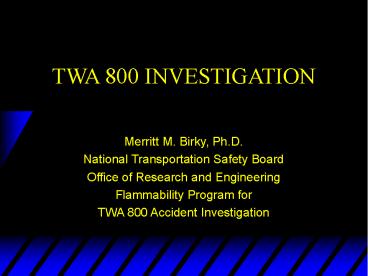TWA 800 INVESTIGATION - PowerPoint PPT Presentation
Title:
TWA 800 INVESTIGATION
Description:
... VAPOR SAMPLES DURING FLIGHT DETERMINE TEMPERATURE UNDER CWT TWA 800 INVESTIGATION FLIGHT TEST AIRCRAFT Evergreen Airlines ... Jet A 1 /4 Scale Tests ... Blue.pot ... – PowerPoint PPT presentation
Number of Views:187
Avg rating:3.0/5.0
Title: TWA 800 INVESTIGATION
1
TWA 800 INVESTIGATION
- Merritt M. Birky, Ph.D.
- National Transportation Safety Board
- Office of Research and Engineering
- Flammability Program for
- TWA 800 Accident Investigation
2
Reconstruction
STA 1500
STA 520
3
747-100 CWT
RS
SWB1
MS
Front Spar
SWB2
SWB3
4
INVESTIGATION OBJECTIVE/APPROACH
- Determine cause of explosion to prevent future
accidents of this type - Approach-
- Examine hardware in accident airplane
- Examine wiring in similar airplanes
- Did flight tests to determine conditions in CWT
- Do Jet A flammability testing
5
FLAMMABILITY OF JET A
- FLIGHT TEST
- vapor sampling and temperatures
- LABORATORY EXPLOSION TESTING
- VAPOR CHEMISTRY OF JET A
- 1/4 SCALE EXPLOSION STUDY
- MODELING OF EXPLOSIONS
- FULL SCALE EXPLOSION TESTING
6
TESTING OBJECTIVES
- DETERMINE IGNITION SOURCE OR
- DETERMINE LOCATION OF IGNITION SOURCE
- DETERMINE THE FIRE/EXPLOSION PROPERTIES OF JET A
- DETERMINE IGNITION ENERGY
7
FLIGHT TESTS
- SAFETY BOARD/BOEING
- OBJECTIVES
- DETERMINE CONDITIONS INSIDE THE CWT
- COLLECT VAPOR SAMPLES DURING FLIGHT
- DETERMINE TEMPERATURE UNDER CWT
NTSB
8
TWA 800 INVESTIGATIONFLIGHT TEST AIRCRAFT
- Evergreen Airlines
- 747-121
- Boeing Line number 106
9
FLIGHT TEST INSTRUMENTATION
- Boeing Commercial Airplane Company
- Instrumentation, installation and flight crew
- 153 temperature sensors
- pressure sensors
- vibration sensors
- vapor sampling
10
FLIGHT TEST PROGRAMOVERVIEW
- CWT VAPOR SAMPLES
- During Taxi
- 10,000 feet
- 14,000 feet
- CWT LIQUID SAMPLES
- Before and after flight
11
FLIGHT TEST VAPOR SAMPLING
- UN. OF NEVADA, DESERT RESEARCH INSTITUTE
- DR. JOHN SAGEBIEL
- OBJECTIVE
- DETERMINE CHEMICAL COMPOSITION OF VAPORS IN CWT
DURING FLIGHT
NTSB
12
Center Wing Tank (CWT) Nomenclature
- BAY 1 - Between spanwise beams 2 and 3
- BAY 2 - Between spanwise beam 2 and mid spar
- MID BAYS - Between mid spar and spanwise beam 1
- AFT BAYS - Between spanwise beams 1 and rear spar
- ULLAGE - Space in fuel tank above the liquid
fuel, occupied by fuel vapor
S
SW3
SW2
SW1
13
Center Wing Tank Heating
14
ALTITUDE DATA TWA 800 EMULATION FLIGHT
15
(No Transcript)
16
Fuel to Air Mass and Mole Ratios
17
TWA 800 EMULATION FLIGHTCWT Ullage Temps at
Start of Taxi
18
VAPOR PRESSURE MEASUREMENTS
- UN. OF NEVADA, RENO
- MR. JIM WOODROW
- OBJECTIVES
- DETERMINE VAPOR PRESSURE AS A FUNCTION OF
TEMPERATURE AND ULLAGE/LIQUID RATIO - CHEMICALLY CHARACTERIZE THE VAPORS
19
LABORATORY EXPLOSION TESTING
- CALIFORNIA INSTITUTE OF TECHNOLOGY
- PROF. JOSEPH SHEPHERD
- OBJECTIVES
- MEASURE RATE OF PRESSURE RISE
- PEAK PRESSURE
- MINIMUM IGNITION ENERGY
20
Vapor Pressure of LAX Jet A
21
Pressure Histories
time (s)
22
Jet A Composition
Woodrow data on Reno Jet A
23
1/4 SCALE EXPLOSION TESTING
- OBJECTIVES
- STUDY EFFECTS OF IGNITION LOCATION ON PRESSURE
DYANMICS - STUDY THE EFFECTS OF FLAME COMMUNICATIONS BETWEEN
COMPARMENTS
24
Why do scale model experiments?
Goal
Develop insight into a complex combustion problem
- Issues that we could not examine in the lab
- motion of flames between bays
- acceleration of flames by turbulence in bays
- dispersion of liquid jet fuel as spray or mist
- failure of SWB3, FS, access panel in SWB2
- Test cases for numerical simulation of flames
- Step toward goal of finding ignition source
25
Actual Test Fixture
26
Simulant Fuel vs. Jet A Vapor
Idea Match pressure rise and flame speed of Jet
A created from a liquid layer (scaled to 50 gal
in CWT) at 50 C
27
Flame Ignition and Growth
spark
Jet A simulant
28
Failure of Beams and Spars
29
Ignition Locations
- Parametric study
- Fuel probe, compensator, terminal block
locations
30
Test 04 - Pressure Data
4.5
4
bay 6
3.5
bay 5
3
bay 4
2.5
bay 3
pressure rise (bar)
2
bay 2
1.5
bay 1
1
0.5
0
0.1
0.12
0.14
0.16
0.18
0.2
0.22
0.24
time (s)
31
1/4 Scale with Jet A on Bottom
32
COMPUTER MODELING
- OBJECTIVES
- PREDICT EFFECTS OF IGNITION IN DIFFERENT
LOCATIONS IN CWT - PREDICT EFFECTS OF COMMUNICATION BETWEEN BAYS
33
COMPUTER MODELING
- SANDIA LABORATORIES
- DR. MELVIN BAER
- CHRISTIAN MICKELSON RESEARCH
- DR. KEES VAN WINGERTEN
- COMBUSTION DYNAMICS
- DR. PAUL THIBAULT
NTSB
34
Recent Activities
- Repeatability 1/4 scale testing
- 1/4 Scale tests with Jet A fuel
- Sensitivity Analysis on Ignition Location
- Development of Tank/AC Thermal Model
35
Primary Objective
- Determine most probable ignition location based
on - Observed Damages
- Fuel/Temperature distribution obtained from
flight test data
36
Approach
Rule Based Scenario Analysis
37
Approach
Rule Based Scenario Analysis
38
BRUNTINGTHROPE TEST
- NTSB/DERA
- OBJECTIVES
- DETERMINE SIGNATURE OF SMALL EXPLOSIVE CHARGES ON
CWT - DETERMINE EFFECTS OF EXPLODING A HYDROCARBON GAS
IN CWT
39
What have we learned?
- Combustion occurs quickly in other bays once
ignition bay burns - Ignition location influence observable but no
smoking gun yet - Extremely challenging inverse problem
- Where was fuel vapor?
- Numerical simulation of full-scale explosion
- Numerical simulation of structural failure
- Quenching of flame between bays appears important
40
Activities in Progress
- Explore Feasibility of coupling CFD model with
Structural Model - Analysis of Jet A 1/4 Scale Tests
- Analysis of Flame Quenching































